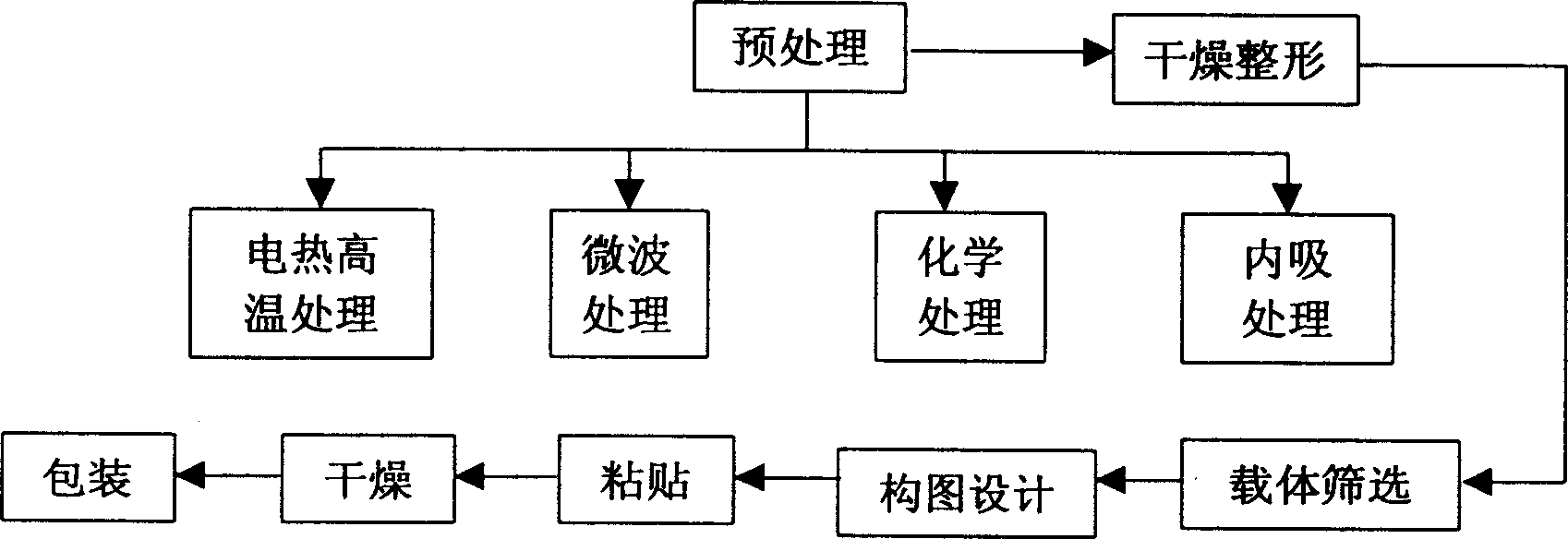Method for making art ware by natural plant
A technology of natural plants and handicrafts, applied in decorative arts, special decorative structures, pasting and other directions, can solve the problems of plants losing their natural color and shape, unable to obtain the original color of plants, and the impact of ornamental value, achieving promising prospects and improving artistic appreciation. Practicality and practicability, and the effect of high added value
- Summary
- Abstract
- Description
- Claims
- Application Information
AI Technical Summary
Problems solved by technology
Method used
Image
Examples
Embodiment 1
[0038] Embodiment 1: The composition design is a natural growth type.
[0039] A method of making handicrafts with natural plants, using rose stems, leaves, flowers and flower buds as raw materials, firstly pretreating the collected and screened roses, the stems and leaves must be chemically treated, that is, 5% saturated different The concentration of CuSO4 solution is heated to 85°C-boiling, and then the fresh stems and leaves are soaked in the solution until the green color is restored; the flowers are treated by systemic absorption method, and the food coloring is prepared into a concentration of 0.1%-0.3%. solution, and then put fresh rose flowers into the solution for living body color absorption for 0.5-2 hours, so that it can obtain the desired color, and then take it out from the solution; It is placed in a drying oven at 80°C-100°C to dry until the bud skin is dry, and then put the above-mentioned pretreated rose stems, leaves, flowers and flower buds into a drying s...
Embodiment 2
[0040] Example 2: The composition is designed as a combined flower arrangement
[0041] A method for making handicrafts with natural plants, the method of making handicrafts with leaves, flowers, fruits and vegetables of plants as raw materials, the fruits include: lemons, mangoes, oranges, grapes, and vegetables include: cucumbers, rapeseed, cherry radishes, pickles Capsicum; plants include: leaves of purple-leaved plum and humulus; flowers of yellow thorn rose, crabapple, and buttercup. First, the surface of fruits and vegetables is cleaned, the internal spongy tissue and vascular tissue are removed, and the epidermal tissue is retained, and then the electric heat treatment is performed, and it is placed in a drying oven at 80°C-100°C to dry until the fruit epidermis Until it is dry, the leaves of Ziye Plum and Humulus are treated chemically, that is, 5% saturated CuSO4 solutions of different concentrations are heated to 85°C-boiling, and then fresh leaves are soaked in the ...
Embodiment 3
[0042] Example 3: The composition design is traditional Chinese painting
[0043] A method of making handicrafts with natural plants, using plant bark, branches, leaves and vegetables as raw materials, the bark includes: birch bark, willow bark and paulownia bark; the branches include: willow branch, peach branch, pomegranate Branches and rose branches; leaves include: willow leaves and lotus leaves; flowers include: pomegranate, lotus, rose, chrysanthemum, plum grass and African orange; vegetables use eggplant, first clean the surface of the eggplant to remove the internal spongy tissue and vascular bundles Tissue, keep the epidermis tissue, and then perform high-temperature electrothermal treatment, and place it in a drying oven at 80°C-100°C to dry until the epidermis is dry. Chemically treat the above-mentioned branches and leaves, that is, first heat 5% saturated CuSO4 solutions of different concentrations to 85°C-boiling, then soak the branches and leaves in the solution...
PUM
 Login to View More
Login to View More Abstract
Description
Claims
Application Information
 Login to View More
Login to View More - R&D
- Intellectual Property
- Life Sciences
- Materials
- Tech Scout
- Unparalleled Data Quality
- Higher Quality Content
- 60% Fewer Hallucinations
Browse by: Latest US Patents, China's latest patents, Technical Efficacy Thesaurus, Application Domain, Technology Topic, Popular Technical Reports.
© 2025 PatSnap. All rights reserved.Legal|Privacy policy|Modern Slavery Act Transparency Statement|Sitemap|About US| Contact US: help@patsnap.com

